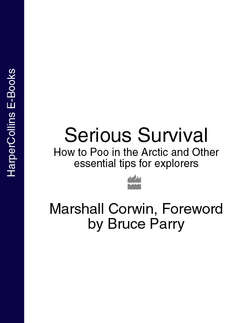Читать книгу Serious Survival: How to Poo in the Arctic and Other essential tips for explorers - Bruce Parry - Страница 16
Arctic Clothing
ОглавлениеGetting your clothing right is critical in the Arctic. You need to be thinking constantly about what you’re wearing, adding or taking off layers to make sure you never get too cold – or too hot (see page).
Clothes largely keep you warm by trapping air to insulate you, and the principle is to wear lots of thinner layers rather than a couple of really thick ones. This way you can adjust your temperature more easily.
As you first put on your underwear and thermals, it’s a sobering thought that you may well not change them for the entire expedition. Somehow, the complex logistics of changing pants at –30°C (–22°F) doesn’t often seem worth it.
Everyone has their favourite expedition clothing that they feel most comfortable with, and as long as you keep to the basic principles it really doesn’t matter.
The kit used in Serious Arctic is ‘modelled’ below by two of the young adventurers. On their feet they wore two pairs of socks and special ‘moon’ boots. Legs had three layers: thermal leggings, trekking trousers and windproof over-trousers.
Their top half was covered in up to six layers: two thermal vests, a thin fleece, Arctic hoodie, windproof jacket with fur round the hood and a thick puffer jacket.
Finally the neck and head was protected by a neck gaiter, balaclava, ‘head-over’ scarf, hat, goggles and hood. It’s important to cover your head at all times to prevent heat loss – once you’re dressed, more than one-third of the body’s heat is lost via your head. Goggles can be customised with a nose-guard. If ‘warm’ enough not to wear goggles, a good pair of sunglasses which block UV-rays is a must to avoid snow blindness.
Protect your hands with one or two pairs of gloves plus some outer mitts. Thin inner gloves are a good idea for more fiddly jobs like taking photos. Bare hands will be aching with the cold and going numb in seconds, and will stick to metal as the moisture on your skin freezes on contact with the cold surface.
When fully kitted out some people feel quite claustrophobic. Everyday tasks like going to the toilet become a major logistical exercise (see page).
When everyone’s in full Arctic kit, it’s a real problem to figure out who’s who.
IS IT POSSIBLE to stay warm in temperatures as low as minus fifty?
It may seem unlikely, especially when you can go outside back home and feel freezing in temperatures well above zero, but it is certainly achievable. The truth is that most people don’t wear the right clothes to keep them warm in their everyday lives (usually being more concerned about fashion).
In the Arctic it’s rather more crucial to be really clued up. The key is to use lots of layers, trapping air between your clothes for insulation, and to cover up all exposed flesh when the weather gets seriously cold. In extreme low temperatures it’s important not to let yourself even start to get chilled as it’s much harder to get warm again.
HOW DO YOU stop your feet getting cold?
A real worry, as anyone who’s stood around waiting for a bus on an icy winter’s day will know. Whatever footwear you’ve got on, the heat eventually seems to just drain away into the pavement.
But the good news is that special ‘moon’ boots have been developed for use in extreme conditions. With thick rubber insulating soles and separate felt liners, they’ll keep your feet warm down to a reassuringly low –100°C (–148°F), colder even than the Arctic.
COLD COMFORT
The object of the layering system is to keep the heat in and the icy wind out, and to allow your body to ‘breathe’, preventing the build-up of perspiration (damp clothes next to your skin have almost no insulating properties). Fit is crucial. Too tight and clothes won’t allow a layer of air next to the skin, too loose and there will be too much air to warm up effectively.
| Inner layer(s) | Thermals with good wicking properties. This means they actually take moisture away from the skin and transfer it to their outer surface without the thermals themselves getting wet. Avoid cotton, which gets too damp. |
| Middle layer(s) | Fleece to keep you warm (modern fleeces will again continue ‘wicking’ moisture away from your body). |
| Outer layer | Windproofs to keep out the biting polar wind. |
| Extra layer | Extremely warm clothing, for example, thick puffer jacket, usually only for use when stopped outside to prevent getting chilled. |
